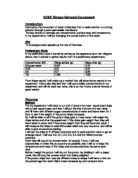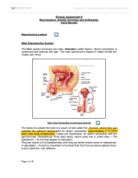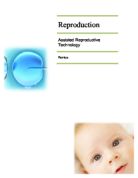- It also has acrosome in the head which contains digestive enzyme that breaks down the egg’s zona pellucida, allowing the sperm to penetrate the egg.
- Egg cells have follicle cells and zona pellucida - forming a protective coating/ layer that the sperm must penetrate.
- Both sperm and egg cells have haploid nucleus (half no. of chromosome - n), this is to produce a zygote with the full set of chromosomes (2n).
- The egg cells release cortical granules after the first sperm penetration in order to prevent polyspermy (multiple sperm penetration).
- There are several stages to fertilisation:
- Capacitation: Changes occur to the sperm to allow it to swim more freely (i.e. Tail can swim faster) there’re also changes to the membrane around the acrosome, allowing it to release enzyme when in contact with the egg.
- Acrosome reaction (where enzyme is released) digests zona pellucida (a glycoprotein barrier). Receptor on acrosome membrane binds to receptor protein on zona pellucida, releasing all the enzymes.
During the process the acrosome swells and the vesicle containing acrosome fuses with the sperm’s cell surface membrane – the acrosome is released via exocytosis.
- Only the nucleus of sperm enters the egg cell and the tail is discarded. Also cortical granules are released by exocytosis of vesicles, altering the zona pellucida to prevent further entry of sperms. It thickens the zona pellucida, making the membrane impenetrable.
- The secondary oocyte is stimulated to complete meiosis II (from where it’s left off at metaphase II) the 2 haploid nuclei fuses (this is fertilisation) and a zygote is formed - mitosis immediately begins.
Plant Fertilisation
- A pollen grain lands on the stigma of a flower, the grain absorbs water and splits open. A pollen tube grows out of the grain down the style.
- There are 3 nuclei in the pollen tube, 2 male gamete nuclei behind 1 tube nucleus at the tip of the tube which makes enzyme that digests surrounding cells, making a way through for the pollen tube.
- When the tube reaches the ovary, it grows through the micropyle (which is a tiny hole in the ovule wall) and into the embryo sac within the ovule.
- In the embryo sac, the tube nucleus disintegrates and the tip of the pollen tube bursts, releasing the two male nuclei into the sac.
- One male nucleus fuses with the egg nucleus to make a zygote. The zygote divides by mitosis to form the embryo of the seed.
- Whereas the second male nucleus fuses with two other nuclei (called the polar nuclei) at the centre of the embryo sac - producing a cell with a large nucleus, which divides to become a food store (endosperm - 3n) for the mature seed.
- A double fertilization has taken place and this only happens in flowering plants.
Production of gametes
- Meiosis occurs in reproductive systems to produce gametes; the original call contains full number of chromosomes, however the daughter cells are haploid cells so would only have half the original number of chromosomes
Without meiosis, the zygote would have 2x the number of chromosome when the gamete fuses during fertilisation. Meiosis produces genetically different gametes.
- During meiosis the DNA replicates so there’re two identical copies of each chromosome, called chromatids. Then they condense to form double stranded
Chromosomes, again consisting of 2 sister chromatids connected at the centromere.
Chromosomes arrange themselves into homologous pairs – pairs of matching chromosomes (i.e. both are chromosome no. 1) each of the chromosome in a pair is form each parent, paternal and maternal.
During 1st division, homologous pairs are separated, halving the number of chromosomes and in the 2nd division, the pair of sister chromatids are separated at the centromere (by spindle fibres) – this halves the no. of chromosomes again.
- Genetic variation refers to the differences that exists between individuals’ genetic materials (different combination of alleles) and meiosis creates this variation:
CROSSING OVER OF CHROMATIDS
-
Before the 1st division in meiosis, homologous pairs (maternal and paternal version of the same chromosome) of chromosomes pair up and a chromatid from each chromosome in a homologous pair twist around each other.
- The twisted section breaks off their original chromatids and rejoins onto the other chromatids and recombines their genetic material.
- The point of crossing is called the chiasmata. After crossing over, the chromatid would still have the same genes but with different combination of alleles.
INDEPENDENT ASSORTMENT
- This is where different combination of the paternal and maternal chromosomes goes into each cell when gametes are produced. Therefore in the 23 chromosomes in each games, any number from none to all 23 could be form either the maternal or paternal chromosomes.
Human Fertilisation
- The mammalian gametes are specialized for their functions:
- Sperm cells have lots of mitochondria in their midpiece to provide energy for the flagellum to move and swim strongly towards the egg
- It also has acrosome in the head which contains digestive enzyme that breaks down the egg’s zona pellucida, allowing the sperm to penetrate the egg.
- Egg cells have follicle cells and zona pellucida - forming a protective coating/ layer that the sperm must penetrate.
- Both sperm and egg cells have haploid nucleus (half no. of chromosome - n), this is to produce a zygote with the full set of chromosomes (2n).
- The egg cells release cortical granules after the first sperm penetration in order to prevent polyspermy (multiple sperm penetration).
- There are several stages to fertilisation:
- Capacitation: Changes occur to the sperm to allow it to swim more freely (i.e. Tail can swim faster) there’re also changes to the membrane around the acrosome, allowing it to release enzyme when in contact with the egg.
- Acrosome reaction (where enzyme is released) digests zona pellucida (a glycoprotein barrier). Receptor on acrosome membrane binds to receptor protein on zona pellucida, releasing all the enzymes.
During the process the acrosome swells and the vesicle containing acrosome fuses with the sperm’s cell surface membrane – the acrosome is released via exocytosis.
- Only the nucleus of sperm enters the egg cell and the tail is discarded. Also cortical granules are released by exocytosis of vesicles, altering the zona pellucida to prevent further entry of sperms. It thickens the zona pellucida, making the membrane impenetrable.
- The secondary oocyte is stimulated to complete meiosis II (from where it’s left off at metaphase II) the 2 haploid nuclei fuses (this is fertilisation) and a zygote is formed - mitosis immediately begins.
Plant Fertilisation
- A pollen grain lands on the stigma of a flower, the grain absorbs water and splits open. A pollen tube grows out of the grain down the style.
- There are 3 nuclei in the pollen tube, 2 male gamete nuclei behind 1 tube nucleus at the tip of the tube which makes enzyme that digests surrounding cells, making a way through for the pollen tube.
- When the tube reaches the ovary, it grows through the micropyle (which is a tiny hole in the ovule wall) and into the embryo sac within the ovule.
- In the embryo sac, the tube nucleus disintegrates and the tip of the pollen tube bursts, releasing the two male nuclei into the sac.
- One male nucleus fuses with the egg nucleus to make a zygote. The zygote divides by mitosis to form the embryo of the seed.
- Whereas the second male nucleus fuses with two other nuclei (called the polar nuclei) at the centre of the embryo sac - producing a cell with a large nucleus, which divides to become a food store (endosperm - 3n) for the mature seed.
- A double fertilization has taken place and this only happens in flowering plants.










